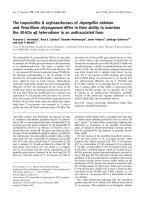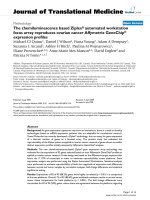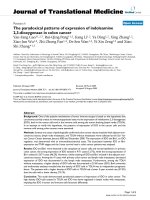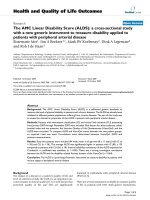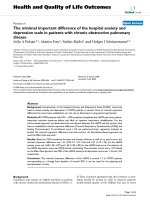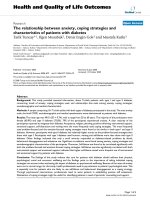báo cáo hóa học: " The possible link between the elevated serum levels of neurokinin A and anti-ribosomal P protein antibodies in children with autism" pot
Bạn đang xem bản rút gọn của tài liệu. Xem và tải ngay bản đầy đủ của tài liệu tại đây (197.62 KB, 30 trang )
This Provisional PDF corresponds to the article as it appeared upon acceptance. Fully formatted
PDF and full text (HTML) versions will be made available soon.
The possible link between the elevated serum levels of neurokinin A and
anti-ribosomal P protein antibodies in children with autism
Journal of Neuroinflammation 2011, 8:180 doi:10.1186/1742-2094-8-180
Gehan A Mostafa ()
Laila Y Al-Ayadhi ()
ISSN 1742-2094
Article type Research
Submission date 8 October 2011
Acceptance date 21 December 2011
Publication date 21 December 2011
Article URL />This peer-reviewed article was published immediately upon acceptance. It can be downloaded,
printed and distributed freely for any purposes (see copyright notice below).
Articles in JNI are listed in PubMed and archived at PubMed Central.
For information about publishing your research in JNI or any BioMed Central journal, go to
/>For information about other BioMed Central publications go to
/>Journal of Neuroinflammation
© 2011 Mostafa and Al-Ayadhi ; licensee BioMed Central Ltd.
This is an open access article distributed under the terms of the Creative Commons Attribution License ( />which permits unrestricted use, distribution, and reproduction in any medium, provided the original work is properly cited.
1
The possible link between the elevated serum levels of
neurokinin A and anti-ribosomal P protein antibodies in children
with autism
Gehan A Mostafa
1,2
, Laila Y AL-Ayadhi
1
1
Autism Research and Treatment Center, AL-Amodi Autism Research Chair,
Department of Physiology, Faculty of Medicine, King Saud University, Riyadh, Saudi
Arabia and
2
Department of Pediatrics, Faculty of Medicine, Ain Shams University,
Cairo, Egypt
Corresponding Author: Gehan Ahmed Mostafa
Address: 9 Ahmed El-Samman Street off Makram Ebaid, Nasr City, Cairo,
Egypt.
E-mail.:
,
2
Abstract:
Background: Neurogenic inflammation is orchestrated by a large number of neuropeptides.
Tachykinins (substance P, neurokinin A and neurokinin B) are pro-inflammatory
neuropeptides that may play an important role in some autoimmune neuroinflammatory
diseases. Autoimmunity may have a role in the pathogenesis of autism in some
patients. We are the first to measure serum neurokinin A levels in autistic children.
The relationship between serum levels of neurokinin A and anti-ribosomal P protein
antibodies was also studied.
Methods: Serum neurokinin A and anti-ribosomal P protein antibodies were
measured in 70 autistic children in comparison to 48 healthy-matched children.
Results: Autistic children had significantly higher serum neurokinin A levels than
healthy controls (P < 0.001). Children with severe autism had significantly higher
serum neurokinin A levels than patients with mild to moderate autism (P < 0.001).
Increased serum levels of neurokinin A and anti-ribosomal P protein antibodies were
found in 57.1% and 44.3%, respectively of autistic children. There was significant
positive correlations between serum levels of neurokinin A and anti-ribosomal P
protein antibodies (P = 0.004).
Conclusions: Serum neurokinin A levels were elevated in some autistic children and
they were significantly correlated to the severity of autism and to serum levels of anti-
ribosomal P protein antibodies. However, this is an initial report that warrants further
research to determine the pathogenic role of neurokinin A and its possible link to
autoimmunity in autism. The therapeutic role of tachykinin receptor antagonists, a
potential new class of anti-inflammatory medications, should also be studied in
autism.
3
Keywords: Anti-ribosomal P protein antibodies; autism, autoimmunity, neurokinin
A.
4
Background
Neurogenic inflammation encompasses a series of vascular and non-vascular
inflammatory responses, triggered by the activation of primary sensory neurons, with a
subsequent release of inflammatory neuromediators. This results in a neurally mediated
immune inflammation [1,2]. Neuromediators are mainly released from neurons. Immune
and/or structural cells are secondary sources of these mediators during immune inflammation
[3,4]. Neuromediators include neurotrophins and neuropeptides [4].
Neurogenic inflammation is orchestrated by a large number of neuropeptides
mainly including tachykinins. Tachykinins (substance P, neurokinin A and
neurokinin B) have been considered as a group of neuropeptides which are released
from the excitatory part of the nonadrenergic, noncholinergic excitatory nervous
system nerves after exposure to allergens. The biological activity of tachykinins
depends on their interaction with three specific tachykinin receptors, neurokinin
(NK)1 (specific for substance P), NK2 (specific for neurokinin A) and NK3 (specific
for neurokinin B) receptors [5-7]. Tachykinin receptor antagonists are a potential new
class of anti-inflammatory medicaions in immune-mediated diseases.[8-10].
Autoimmunity may have a role in the pathogenesis of autism in a subgroup of
patients. This may be indicated by the presence of brain-specific auto-antibodies in some
autistic children [11-17]. There is also an increase in the frequency of autoimmune disorders
among autistic families [18-23].
Inspite of the fact that the origins of autoimmunity in
autism are unknown, the major histocompatibility complex genes and their products
might be involved [21, 24-25].
Anti-ribosomal P protein antibodies are one group of potentially pathogenic
autoantibodies that has a specificity for the functional center of the ribosomal P
5
proteins which is a family of highly conserved acidic phosphoproteins primarily
located on the stalk of the large (60s) ribosomal subunit [26]. They bind 3 ribosomal
proteins identified as P0, P1 and P2 (38, 19 and 17-kDa, respectively) by recognizing
a certain epitope found in those 3 proteins. Several possible pathogenic mechanisms
for these antibodies in some autoimmune diseases include their binding to epitopes on
the cell membrane surface, intracellular penetration, inhibition of protein synthesis,
production of pro-inflammatory cytokines and cell apoptosis [27].
Evidence for an interaction between chronic inflammation in autoimmune
diseases and neural dysfunction points to an involvement linking the nervous and the
immune system. In this context, neuropeptides, including tackykinins and
neurotrophins have been recognized as key mediators of neuro-immune interactions in
some autoimmune diseases [28]. Thus, investigations regarding the development of
pharmacological compounds specifically targeting these molecules could be of
interest [29].
This study was the first to measure serum neurokinin A levels in a group of
autistic children. The relationship between serum levels of neurokinin A and anti-
ribosomal P protein antibodies was also studied.
Methods
Study population
This cross-sectional study was conducted on 70 children who had autism.
They were recruited from the Autism Research and Treatment Center, Faculty of
Medicine, King Saud University, Riyadh, Saudi Arabia. Patients were fulfilling the
6
criteria of the diagnosis of autism according to the 4
th
edition of the Diagnostic and
Statistical Manual of Mental Disorders [30]. The autistic group comprised 55 males
and 15 females. Their ages ranged between 4 and 12 years (mean ± SD = 8.10 ± 2.52
years).
Exclusions criteria:
1- Patients who had associated neurological diseases (such as cerebral palsy and
tuberous sclerosis) and metabolic disorders (eg. Phenylketonuria) were excluded form
the study.
2- Patients with associated allergic, inflammatory or autoimmune disorders.
3- Patients who were receiving any medications.
The control group comprised 48 age- and sex- matched apparently healthy
children ( 37 males and 11 females). They were the healthy older siblings of the
healthy infants who attend the Well Baby Clinic, King Khalid University Hospital,
Faculty of Medicine, King Saud University, Riyadh, Saudi Arabia for routine
following up of their growth parameters. The control children were not related to the
children with autism, and demonstrated no clinical findings suggestive of
immunological or neuropsychiatric disorders. Their ages ranged between 6 and 11
years (mean ± SD = 8.79 ± 2.89 years).
The local Ethical Committee of the Faculty of Medicine, King Saud
University, Riyadh, Saudi Arabia, approved this study. In addition, an informed
written consent of participation in the study was signed by the parents or the legal
guardians of the studied subjects.
7
Study measurements
Clinical evaluation of autistic patients: This was based on clinical history
taking from caregivers, clinical examination and neuropsychiatric assessment. In
addition, the degree of the disease severity was assessed by using the Childhood
Autism Rating Scale (CARS) [31] which rates the child on a scale from one to four in
each of fifteen areas (relating to people; emotional response; imitation; body use;
object use; listening response; fear or nervousness; verbal communication; non-verbal
communication; activity level; level and consistency of intellectual response;
adaptation to change; visual response; taste, smell and touch response and general
impressions). According to the scale, children who have scored 30-36 have mild to
moderate autism (n = 34), while those with scores ranging between 37 and 60 points
have a severe degree of autism (n = 36).
Serum assessment of neurokinin A: Serum levels of neurokinin A were
evaluated with an enzyme-linked immunosorbent assay (ELISA) kit which is highly
sensitivie to neurokinin A. Neurokinin A like immunoreactivity was measured using
an antibody that has originally been isolated from porcine spinal cord. It shows 100%
cross reactivity to neurokinin A with little reactivity to other tachykinins (Peninsula
laboratories, 611 Talorwat, Belmont, CA, USA).To increase accuracy, all samples
were analysed twice in two independent experiments to assess the interassay
variations and to ensure reproducibility of the observed results (P > 0.05). No
significant cross-reactivity or interference was observed.
Measurement of serum anti-ribosomal P protein antibodies: Serum total
IgG and IgM anti-ribosomal P protein antibodies were measured by ELISA using
ribosomal P peptide-bovine serum albumin conjugate as an antigen (Nunc immuno
8
module F8 maxisorp; Nunc. Roskilde, Denmark). To increase accuracy, all samples
were analysed twice in two independent experiments to assess the interassay
variations and to ensure reproducibility of the observed results (P > 0.05). No
significant cross-reactivity or interference was observed.
Statistical analysis
The results were analyzed by commercially available software package
(Statview, Abacus concepts, inc., Berkley, CA, USA). The data were non-parametric,
thus they were presented as median and interquartile range (IQR), which are between
the 25
th
and 75
th
percentiles. Mann-Whitney test was used for comparison between
these data. Chi-square test was used for comparison between qualitative variables of
the studied groups. Spearman's rho correlation coefficient "r" was used to determine
the relationship between different variables. For all tests, a probability (P) of less than
0.05 was considered significant. Patients were considered to have elevated serum
neurokinin A or anti-ribosomal P protein antibodies if their levels were above the
highest cut-off values (107.4 pg/ml and 92 units/ml, respectively) which were the 95
th
percentiles of serum neurokinin A and anti-ribosomal P levels, respectively of
healthy controls as the distribution of the data was non-parametric.
9
Results
Serum Neurokin A levels in autistic children and their relation to the degree of
the severity of autism
Autistic children had significantly higher serum neurokinin A levels than
healthy controls, P < 0.001 (table 1). Increased serum neurokinin A levels were found
in 57.1% (40/70) of autistic patients.
Patients with severe autism had significantly higher serum neurokinin A levels
than children with mild to moderate autism, P < 0.001 (table 1). Also, the frequency
of increased serum neurokinin A levels was significantly higher in children with
severe autism (31/36: 77.5%) than patients with mild to moderate autism (9/34:
26.5%), P < 0.001. Moreover, there were significant positive correlations between
serum levels of neurokinin A and CARS in autistic patients, P < 0.001 (figure 1).
Male and female autistic children had comparable values of serum neurokinin
A (P = 0.52). In addition, serum neurokinin A levels had no significant correlations
with the age of the children with autism (P = 0.68).
The relationship between the elevated serum levels of neurokinin A and anti-
ribosomal P protein antibodies in autistic children
Increased serum levels of anti-ribosomal P protein antibodies were found in
44.3% (31/70) of autistic patients. Patients with elevated serum neurokinin A levels
had significantly higher serum levels of anti-ribosomal P protein antibodies [median
(IQR): 115 (467) U/ml) than patients with normal serum neurokinin A levels [median
(IQR): 23.5 (248) U/ml), P = 0.02. In addition, there were significant positive
10
correlations between serum levels of neurokinin A and anti-ribosomal P protein
antibodies in autistic patients, P = 0.004 (figure 2).
Discussion
Tachykinins are traditionally viewed as neuropeptides with well-defined
functions as neurotransmitters. Tachykinin peptides have also an impact on the
function of the immune system [32].
In our series, autistic children had significantly higher serum neurokinin A
levels than healthy controls, P < 0.001. Increased serum neurokinin A levels were
found in 57.1% of autistic patients. We could not trace data in the literature
concerning neurokinin A levels in the blood of autistic patients to compare our results.
This study was the first to investigate serum neurokinin A levels in autistic children.
In a recent study some neuropeptides were investigated in autistic children. It
reported increased serum levels of neurotensin, while the other studied neuropeptides
(β-endorphin and substance P) were not reported to be increased in these children
[33]. Many studies reported that tachykinins may also be produced by non-neuronal
cells, such as immune cells after exposure to inflammatory stimuli and they exert
profound influence on the inflammatory responses by affecting multiple aspects of
immune cell function [32]. In one study, the elevated sputum neurokinin A levels had
significant positive correlations to eosinophil counts in both blood and sputum of
asthmatic children during exacerbation [34]. Thus, the reason behind the increase of
serum neurokinin A levels in autistic children may be the stimulation of the immune
11
cells, after exposure to some environmental antigens (such as food allergens,
infectious agents and heavy metals), with a subequent increase in the release of this
tachykinin from these cells.
Neuroendocrine hormones, including tackykinins, triggered during stress may
lead to immune dysregulation resulting from altered cytokine production, resulting in
autoimmune or atopic diseases. Thus, the stress response with subsequent induction of
a dysregulation of cytokine balance can trigger the hypothalamic-pituitary-adrenal
axis and sympathetic nervous system through overproduction of neuropeptides and
cytokines. In several autoimmune diseases such as rheumatoid arthritis, systemic
lupus erythematosus (SLE), and diabetes mellitus, the immune dysregulation may be
attributable to the neuroendocrine-immune network imbalance through
overproduction of neuropeptides and cytokines [35]. One member of tachykinins,
substance P, was reported to be increased in the cerebrospinal fluid obtained from
patients with multiple sclerosis. Similar to autism, multiple sclerosis is an
inflammatory disease of the CNS that is generally believed to represent an auto-
immunological response to a component of myelin triggered by an environmental
factor, in a genetically susceptible individual [36]. Substance P, through NK-1
receptors, contributes to the maintenance of CNS inflammation in multiple sclerosis.
NK-1 antagonists, with the conventional anti-inflammatory treatments, may enhance
the success of the treatment of some autoimmune diseases such as multiple sclerosis
[37].
Tachykinin 1 gene is located in the candidate region for autism and produces
substance P and neurokinins. These products modulate glutamatergic excitatory
12
synaptic transmission and are also involved in inflammation which could be involved
in the autistic brain. Therefore, tachykinin 1 gene may have some functions
associated with the presumable pathophysiology of autism. To elucidate the genetic
background of autism, one study analyzed the relationship between three single
nucleotide polymorphisms of the tachykinin 1 gene and autism in the Japanese
population, but no significant difference was observed between autistic children and
healthy controls [38].
In the present work, patients with severe autism had significantly higher serum
neurokinin A levels than children with mild to moderate autism, P < 0.001. Also, the
frequency of increased serum neurokinin A levels was significantly higher in children
with severe autism (77.5%) than patients with mild to moderate autism (26.5%), P <
0.001. Moreover, there were significant positive correlations between serum levels of
neurokinin A and CARS in autistic patients, P < 0.001. This may indicate that the
extent of the elevation of serum neurokinin A was closely linked to the degree of the
severity of autism. However, it is not easy to determine whether the increase in serum
neurokinin A levels is a mere consequence of autism or has a pathogenic role in the
disease.
While glial cells are recognized for their roles in maintaining neuronal
function, there is a growing evidence of the ability of resident glial cells to initiate
and/or augment inflammation following exposure to allergens, trauma or infection in
CNS. The tachykinins are found throughout the CNS, with an evidence for both
neuronal and glial cells as being sources of them. Tachykinins are well known to
augment inflammatory responses at peripheral sites, such as the gastrointestinal tract
13
and skin, which raises the possibility that they might serve a similar function within
the brain. Tachykinins may have a role in augmenting the immune functions of CNS
glial cells resulting in the progression of damaging inflammation within the CNS [39].
Brain mast cells in some autoimmune neuroinflammatory diseases of CNS such as
multiple sclerosis are activated by neural factors, including tachykinins. Mast cells
can stimulate the activated T cells coming in contact with them at the blood-brain
barrier In addition, brain mast cells secrete numerous proinflammatory and
vasoactive molecules that can disrupt the blood-brain barrier, a finding that precedes
clinical or pathologic signs of some autoimmune neuroinflammatory diseases of CNS
[40].
Autoimmunity to CNS may have a pathogenic role in autism [41-44]. This
may be indicated by the presence of brain-specific auto-antibodies in some autistic
children [11-17]. In our series, increased serum levels of anti-ribosomal P protein
antibodies were found in 44.3% of autistic patients. This study was the first to
investigate serum levels of anti-ribosomal P protein antibodies in autistic children.
Auto antibodies are the hallmark of autoimmune diseases.
The reason behind the
formation of some auto-antibodies in some patients with autism is not fully
understood. It is speculated that autoimmune reaction might be trigged by cross-
reacting antigens in the environment resulting in the release of some self antigens.
These antigens may result in the induction of autoimmune reactions through the
activation of inflammatory cells in genetically susceptible individuals [41,42].
Anti-ribosomal P protein antibodies are highly specific for SLE, especially for
the neuropsychiatric manifestations including psychosis, mood disorders, anxiety,
14
cognitive dysfunction and delirium [45]. A recent study has demonstrated a strong
association between the seropositivity of anti-ribosomal P protein antibodies and the
presence of neuropsychiatric manifestations in a group of children with SLE [46].
There are some studies in the literature relating anti-ribosomal P protein antibodies to
the pathogenesis of organ damage in SLE. The main pathways described are cross-
reaction with anti-dsDNA antibodies, a cytotoxic effect on mesangium cell
proliferation, invasion into living cells and starting apoptosis, a defect in the synthesis
of apolipoprotein B resulting in accumulation of lipids inside the cell, and
downregulation of the total protein synthesis. P proteins are post-translationally
modified (dephosphorylated) during apoptosis, and a dysregulation in the normal
clearance of apoptotic cells leads to aberrant exposure of the immune system to
modified non self-antigens. This could be one of the triggering events for the
development of anti-P autoimmune response in some autoimmune diseases [45].
Moreover, in an experimental study, mice that had been received intra-
cerebroventricular injection of anti-ribosomal P protein antibodies developed
depression-like behaviors, which seems to be mediated by specific binding of these
antibodies to limbic system brain areas, such as hippocampus and cingulate. It has
been propsed that anti-ribosomal P protein antibodies both directly or indirectly
affect CNS and produce a cytotoxic effect on neuronal cells. The mechanism by
which these antibodies cross the blood brain barrier is unknown [47].
The potential role of neuropeptides in the progression and amplification of the
immune neurogenic inflammation is of a great interest. These effects are described by the
term immunological plasticity that include enhancement of survival, differentiation, and/or
proliferation of immune cells and activation of the release of cytokines or mediators [48].
15
Therefore, neurogenic inflammation describes a vicious cycle of neuroimmune interactions
that amplify immunogenic inflammation and neuropeptides are cross talks between the
immune and nervous systems in immunogenic inflammation [49,50].
As neuropeptides were reported to have a possible role in some systemic
autoimmune diseases and autoimmune neuroinflammatory diseases [35-37], we have
tried to find a possible link between the elevated serum levels of neurokinin A and
anti-ribosomal P protein antibodies in autism. In this work, patients with elevated
serum neurokinin A levels had significantly higher serum levels of anti-ribosomal P
protein antibodies than patients with normal serum neurokinin A levels, P = 0.02. In
addition, there were significant positive correlations between serum levels of
neurokinin A and anti-ribosomal P protein antibodies in autistic patients, P = 0.004 .
We could not trace data in the literature concerning the relationship between serum
levels of neurokinin A and auto-antibodies in autistic patients to compare our results.
We are the first to study such a relationship. The results of this study may indicate
that the elevated serum levels of neurokinin A may be a possible contributing factor
to the increased frequency of anti-ribosomal P protein antibodies in some autistic
children. However, this is an initial report that warrants further research to determine
the possible link between the elevated serum levels of neurokinin A and anti-
ribosomal P protein antibodies.
After exposure to allergens, inflammatory cell (e.g. eosinophils) derived
tachykinins are a major second source of these proinflammatory mediators [3,4] which
can alter the function of the immune system [32]. Tachykinins may induce the so
called neurogenic inflammation by recruitment and activation of the inflammatory
16
cells [3,4]. Neuropeptides were reported to have modulatory effects on immune cells,
in vivo, especially on T-helper (Th)1/Th2 balance. In addition,
neuropeptides can directly stimulate lymphocytes to produce Th2 cytokines, going in
line with the Th2 type shifted immune response [51-53]. Th2 cells orchestrate many
aspects of pathologic immune responses including effector functions of B-cells, mast
cells and eosinophils. These cells produce an array of cytokines such as IL4, IL-5, IL-
9 and IL-13. In some autistic children there is an imbalance of T-helper (Th)1/Th2
subsets toward Th2, which are responsible for allergic response and production of
antibodies
[41].
Thus, the increased seum levels of neurokinin A may explain the increased
frequency of anti-ribosomal P protein antibodies in some autistic children as a result
of Th2 type shifted immune response. However, these data should be treated with a
great caution, until further investigations are performed, as the seropositivity for anti-
ribosomal P protein antibodies in some autistic children may be a mere association
with the increased serum levels of neurokinin A in autism. A more detailed
understanding of the interactions between tachykinins and immune cells may provide
the basis for the development of new therapies for inflammatory and immune-
mediated diseases [32]. Recent findings point to tachykinergic systems as promising
targets of novel clinical agents in many inflammatory diseases [7]. These agents may
antagonize NK2 receptors only [8] or may be NK1/2 receptor antagonists [9,10]
17
Conclusions
Serum neurokinin A levels were elevated in some autistic children and they
were significantly correlated to the severity of autism and to serum levels of anti-
ribosomal P protein antibodies. However, this is an initial report that warrants further
research to determine the pathogenic role of neurokinin A and its possible link to
autoimmunity in autism. The therapeutic role of tachykinin receptor antagonists, a
potential new class of anti-inflammatory medications, should also be studied in
autism.
18
Abbreviations
(CARS): Childhood Autism Rating Scale; (CNS): central nervous system; (IL):
interleukin; (IQR): interquartile range; (Th): T-helper; (SLE): systemic lupus
erythematosus
Competing interests
The authors declare that they have no competing interests.
Authors' contributions
Both authors designed, performed and wrote the research. In addition, both authors
read and approved the final manuscript.
Acknowledgements
This work was financially supported by the King Abdulaziz City for
Science and Technology, Riyadh, Saudi Arabia. It was also supported by
NPST, Health Research and Studies program at Kind Saud University.
19
References
1- Geppetti P, Nassini R, Materazzi S, Benemei S.
The concept of neurogenic inflammation.
BJU Int. 2008; 101 (Suppl 3): 2-6
2- Richardson JD, Vasko MR.
Cellular mechanisms of neurogenic inflammation. J
Pharmacol Exp Ther 2002; 302 (3): 839–45.
3- Nockher WA, Renz H.
Neurotrophins in inflammatory lung diseases: modulators of cell
differentiation and neuroimmune interactions. Cytokine Growth Factor Rev 2003; 14:
559-78.
4- Micera A, Lambiase A, Bonini S
. The role of neuromediators neuromediators in ocular
allergy. Curr Opin Allergy Clin Immunol 2008;8(5):466-71.
5- Maggi CA.
The troubled story of tachykinins and neurokinins. Trends Pharmacol Sci
2000;21: 173–175.
6- Almeida TA, Rojo J, Nieto PM, Pinto FM, Hernandez M, Martin JD, et al.
Tachykinins and
tachykinin receptors: structure and activity relationships. Curr Med Chem 2004; 11:
2045–81.
7- Ramalho R, Raquel Soares R, Nuno Couto N, Moreira A.Tachykinin receptors
antagonism for asthma: a systematic review. BMC Pulm Med. 2011; 11:41.
8- Ettorre A, D'Andrea P, Mauro S, Porcelloni M, Rossi C, Altamura M, et al. hNK2
receptor antagonists. The use of intramolecular hydrogen bonding to increase
20
solubility and membrane permeability. Bioorg Med Chem Lett. 201121(6):1807-
1809.
9- Sigfridsson K, Ahlqvist M, Lindsjö M, Paulsson S. Early development evaluation
of AZD2738, a substrate for the NK receptors. Drug Dev Ind Pharm. 2011; 37(6):719-
726.
10- Sigfridsson K, Ahlqvist M, Carlsson A, Fridström A. Early development
evaluation of AZD8081: a substrate for the NK receptors. Drug Dev Ind Pharm. 2011;
37(6):702-713. Autoimmunity. 2005; 38(1):85-92.
11- Singh VK, Warren RP, Odell J.D, Warren WL, Cole P. Antibodies to myelin
basic protein in children with autistic behavior. Brain Behav Immun. 1993; 7(1):97-
103.
12- Singh VK, Warren RP, Averett R, Ghaziuddin M. Circulating autoantibodies to
neuronal and glial filament proteins in autism. Pediatr Neurol 1997; 17(1): 88-90.
13- Singh VK, Lin SX, Yang VC. Serological association of measles virus and human
herpesvirus-6 with brain autoantibodies in autism. Clin Immunol Immunopathol.
1998, 89(1):105-108.
14- Singh VK, Rivas WH. Prevalence of serum antibodies to caudate nucleus in
autistic children. Neurosci Lett. 2004; 355(1-2):53-56.
15- Mostafa GA, El-Sayed ZA, Abd El Aziz MM, El-Sayed MF. Serum anti-myelin-
associated glycoprotein antibodies in Egyptian autistic children. J Child Neurol. 2008;
23:1413-1418.
21
16- Mostafa GA, Al-Ayadhi, LY. Increased serum levels of anti-ganglioside M1 auto-
antibodies in autistic children: relation to the disease severity. J Neuroinflammation.
2011; 8:39.
17- Mostafa GA, Al-Ayadhi LY. A lack of association between hyperserotonemia and
the increased frequency of serum anti-myelin basic protein auto-antibodies in autistic
children. J Neuroinflammation. 2011 Jun 22;8:71.
18-Comi AM, Zimmerman AW, Frye VH, Law PA, Peeden JN. Familial clustering of
autoimmune disorders and evaluation of medical risk factors in autism. J Child
Neurol .1999; 14:388-394.
19- Sweeten TL, Bowyer SL, Posey DJ, Halberstadt GM, McDougle CJ. Increased
prevalence of familial autoimmunity in probands with pervasive developmental
disorders. Pediatrics. 2003; 112(5):420-424.
20- Mostafa GA, Kitchener N. Serum anti-nuclear antibodies as a marker of
autoimmunity in Egyptian autistic children. Pediatr Neurol. 2009; 40:107-112.
21- Mostafa GA, Shehab A. The link of C4B null allele to autism and to a family
history of autoimmunity in Egyptian autistic children. J Neuroimmunol. 2010;
223:115–119.
22- Mostafa GA, El-Hadidi ES, Hewedi DH, Abdou MM. Oxidative stress in
Egyptian children with autism: relation to autoimmunity. J Neuroimmunol. 2010; 219,
114–118.
22
23- Mostafa GA, Shehab A Al, Fouad NR: Frequency of CD4
+
CD25
high
regulatoryT
cells in the peripheral blood of Egyptian children with autism. J Child Neurol. 2010;
25:328-335.
24- Warren RP, Singh VK, Cole P, Odell JD, Pingree CB, Warren WL., White E.
Increased frequency of the null allele at the complement C4b locus in autism. Clin
Exp Immunol. 1991; 83:438-440.
25- Odell D, Maciulis A, Cutler A,Warren L, McMahon WM, Coon H, et al.
Confirmation of the association of C4B null allele in autism. Human Immunol.
2005,6(2):140-145.
26- Gerli R, Caponi L.Anti-ribosomal P protein antibodies. Autoimmunity. 2005;
38(1):85-92.
27- Toubi E, Shoenfeld Y.Clinical and biological aspects of anti-P-ribosomal protein
autoantibodies. Autoimmun Rev. 2007; (3):119-125.
28- Veres TZ, Rochlitzer S, Braun A. The role of neuro-immune cross-talk in the
regulation of inflammation and remodelling in asthma. Pharmacol Ther.
2009;122(2):203–214.
29- Satake H, Kawada T. Overview of the primary structure, tissue-distribution, and
functions of tachykinins and their receptors. Current Drug Targets. 2006;7(8):963–
974.
30- American Psychiatric Association: Diagnostic and Statistical Manual of Mental
Disorders, 4th ed. Washington DC: American Psychiatric Association, 1994.
23
31- Schopler E, Reichler RJ., Renner BR: The Childhood Autism Rating Scale
(CARS), for Diagnostic Screening and Classification in Autism; New York, NY:
Irvington, 1986.
32- Zhang Y, Berger A, Milne CD, Paige CJ. Brain Dev. Tachykinins in the immune
system. Curr Drug Targets. 2006;7 (8):1011-1020.
33-Angelidou A, Francis K, Vasiadi M, Alysandratos KD, Zhang B, Theoharides A,
et al. Neurotensin is increased in serum of young children with autistic disorder. J
Neuroinflammation. 2010;7:48.
34- Mostafa GA, Reda SM, Abd El-Aziz MM, Ahmed SA. Sputum neurokinin A in
Egyptian asthmatic children and adolescents: relation to exacerbation severity.
Allergy. 2008; (9):1244-1247.
35- Frieri M. Neuroimmunology and inflammation: implications for therapy of
allergic and autoimmune diseases. Ann Allergy Asthma Immunol. 2003; 90(6
Suppl 3):34-40.
36- Qureshi GA, Baig SM, Parvez SH. Variation in cerebrospinal fluid levels of
neuropeptide Y, cholecystokinin and substance P in patients with neurological
disorders. Neuro Endocrinol Lett. 2000;21(5):409-416.
37- Reinke EK, Johnson MJ, Ling C, Karman J, Lee J, Weinstock JV, et al. Substance
P receptor mediated maintenance of chronic inflammation in EAE .J
Neuroimmunol. 2006; 180(1-2):117-125.
24
38- Marui T, Funatogawa I, Koishi S, Yamamoto K, Matsumoto H, Hashimoto O, et
al. Tachykinin 1 (TAC1) gene SNPs and haplotypes with autism: a case-control
study. Brain Dev. 2007; 29 (8):510-513.
39- Marriott I. The role of tachykinins in central nervous system inflammatory
responses. Front Biosci. 2004; 1;9:2153-65.
40- Theoharides TC, Kempuraj D, Kourelis T, Manola A. Human mast cells stimulate
activated T cells: implications for multiple sclerosis. Ann N Y Acad Sci. 2008;
1144:74-82.
41- Cohly HH, Panja A. Immunological findings in autism. Int Rev Neurobiol. 2005;
71:317-341.
42- Vojdani A, Campbell AW, Anyanwu E, Kashanian A, Bock K, Vojdani E.
Antibodies to neuron-specific antigens in children with autism: possible
cross-reaction with encephalitogenic proteins from milk, Chlamydia pneumoniae and
Streptococcus group A. J Neuroimmunol. 2002; 129 (1-2), 168-177.
43- Al-Ayadhi LY, Mostafa GA.Low plasma progranulin levels in children with
autism. J Neuroinflammation. 2011 Sep 5; 8(1):111. [Epub ahead of print]
44- Al-Ayadhi LY, Mostafa GA. Increased serum osteopontin levels in autistic
children: Relation to the disease severity. Brain Behav Immun. 2011; 25(7):1393-
1398.
45- Ben-Ami SD, Blank M, Altman A. The clinical importance of anti-ribosomal-P
antibodies. Harefuah. 2010;149(12): 794-797.
